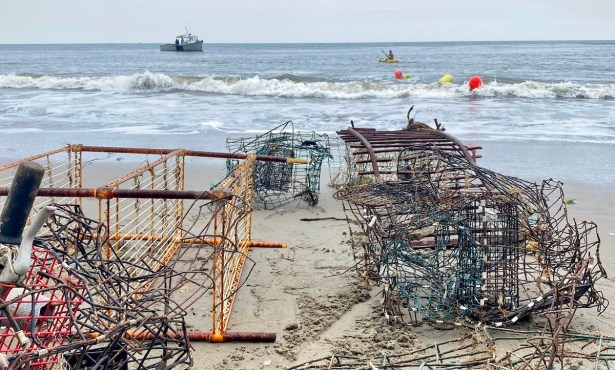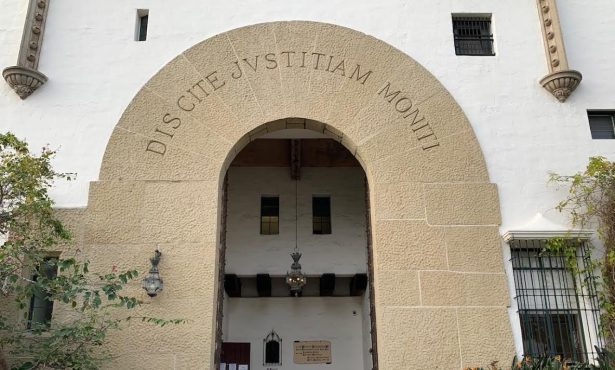Which Way for Goleta Beach?
Save Sand? Protect Lawn? Inside the Debate Over Future of County's Most Popular Park
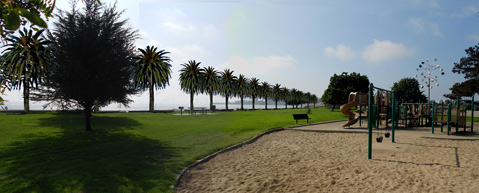
Everyone says they love Goleta Beach, where more than 1.5 million folks of all ages flock annually to enjoy the mix of sandy shoreline and grassy lawn. But when it comes to protecting Santa Barbara County’s most popular park from storm damage and predicted sea-level rise in the decades to come — a decision once again looming for the county powers-that-be, as a study on the latest proposal known as “Goleta Beach 2.0” was released last month — there are two distinct ways of showing that affection.
Protect Park (and Save Sand)
One side of the lovefest wants to do everything possible to protect the easy access and unique park-meets-beach experience offered by the more than 600 parking spaces and four acres of lawn, where barbecues, picnic tables, playgrounds, horseshoe pits, and restrooms abound. This group, led most vocally by the Friends of Goleta Beach organization, believes that the park’s current stretch of rock revetments — some put in legally in the 1960s, some illegally in the 1980s, and the rest installed with a now-expired emergency permit in 2002 — are essentially doing their job.
The California Coastal Commission is demanding those rocks be removed, based on the prevailing environmental credo that “hard” shoreline structures do more harm than good. But the Friends don’t see the rocks causing much permanent damage to this or any downshore beaches. To them, hard is not bad, so long as it protects their favorite place to play. They’re open to solutions that stop any currently developed piece from slipping away, including continuing the ongoing sand replenishment program that moves dredged soil from Goleta Slough to the beach; a return of the protective offshore kelp forest that was wiped away years ago; and even the planting of Canary Island date palm trees, similar to those that have seemingly stabilized Refugio State Beach since the 1930s. The group bought a dozen of those palms a few years ago, but their installation was thwarted by the county.
“What we’re concerned about is the destruction of the park,” said Friends’ founder Ed de la Torre, a multi-generation Goleta resident who started working on this issue in 2002 and sees lots of wasted time and money in the ongoing discussions. “The sand will always be there. There’s no scientific evidence that there’s any environmental damage being caused by these rocks.” [CORRECTION: Nancy Graham of Graham Chevrolet founded Friends of Goleta Beach.]
This position was hammered home this past Tuesday night at the Goleta City Council hearing, where 11 of 12 public speakers advocated for protection the park at all costs. By night’s end, the council voted to send letters to the county decision-makers, stressing how important protecting all the existing park was to the people who visit, live, and work in Goleta.
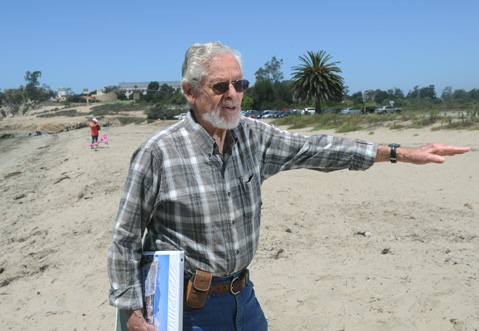
Save Sand (and Protect Park)
The other Goleta Beach lovers are advocating for a more natural process known — with considerable marketing problems — as “managed retreat.” This group, led by the Surfrider Foundation and its hired guns at the Environmental Defense Center (EDC), is against any “hard” structures, wants the current unpermitted rocks removed as soon as possible, and favors letting the beach expand its breadth, even at the potential expense of some parking and lawn areas.
They understand that the rocks have not been exposed in recent years, but believe that, when big storms do eventually come, the uncovered revetments will present a variety of dangers: kids could fall on them, despite the bright orange fences and warning signs that mark those temporary cliffs; the wildlife that lives between the sea and the sand could have their habitats wiped out and die; and, most critically in their eyes, the beach itself, as well as down-shore beaches, may disappear as waves erode away the sands from the hard rocks behind.
“There’s lots of places in Santa Barbara where you can look at the ocean from the top of a cliff,” said Everett Lipman, a UCSB physics professor and member of Surfrider who’s been following this issue since he came to town in 2004. “We think Goleta Beach should be a place where you can run down to the beach and build sand castles.”
Based on a visit during the Fourth of July, which revealed more people using the sand than the lawn and plenty of open parking spots, Lipman believes that Surfrider’s stance does not conflict with the majority of Goleta Beach Park users, explaining that he really wants the same thing as the Friends group. “We all want a nice big lawn with barbecue pits and a big sandy beach,” said Lipman, who regularly takes his son to Goleta Beach. “We just have very different ideas on the best way to accomplish that.”
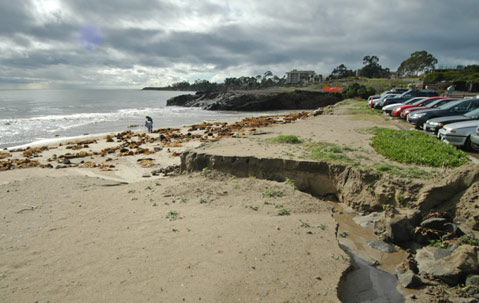
What’s Proposed, and Why?
In 2009, after the Coastal Commission threatened to fine the County of Santa Barbara for the unpermitted rock revetments, the county put forth an idea to create a “permeable groin” off Goleta Pier. Despite its staff’s recommendation to approve, the commissioners voted 9-1 against the idea, swayed in no small part by the lobbying efforts of Surfrider and the EDC, which delivered more than 550 signatures in favor of a more natural solution. The commission told the county to return with a plan that avoided hard structures and explored managed retreat.
Almost exactly four years later, the county released its environmental study of the managed retreat plan this past June. If approved, it would take out the 1,250 feet of unpermitted rocks; remove 107 parking spaces, with 40 more likely to be lost, but with plans to add parking elsewhere; relocate massive utility lines and adjacent bike path closer toward Highway 217; and demolish and potentially move the westernmost restroom. That would leave more than two acres of lawn, 11 picnic areas, two group picnic areas, and another restroom building threatened. “About 60 percent of the lawn area would be susceptible to storm damage,” confirmed county planner Alex Tuttle. “The project, at this point, doesn’t propose whether we would reestablish those areas once they are damaged or destroyed.”
Tuttle explained, however, that the study actually identifies “Alternative 3” as the environmentally preferable option. In exchange for better protecting the western end, that alternative would remove the easternmost parking lot, past the Beachside Café, and turn that into habitat for the snowy plover. It would also include installation of a massive “geotextile” revetment structure to protect the west end of the park, but it would not require any work to begin until a future storm revealed the existing rocks. While the latter notion may have some park protection advocates pleased, the idea of intentionally attracting the plover — a rare bird species whose presence tends to shut down beaches along other parts of the coast — has many folks scratching their heads, and the anti-hard-structure crowd is just as befuddled about the newly proposed revetments.
Back to Square One
Though some of their ideas were incorporated into the study’s “Alternative 2” — an experimental exploration scheme that would test the date palms, underground vinyl walls, sand-trapping beach pipes, and a wave-disrupting machine — the Friends of Goleta Beach aren’t exactly satisfied with the current study. The same can be said for Surfrider and the EDC, which are in the midst of crafting their own alternative. And if the City of Goleta’s hearing on Tuesday night — where the majority of public speakers, not to mention councilmembers Michael Bennett and Jim Farr, expressed visceral anger over losing any portion of the existing Goleta Beach Park while criticizing the environmental community’s grip on the county and Coastal Commission — is any indication, there’s still opposition to anything and everything on the table.
Altogether, lasting decisions about the future of Goleta Beach seem about as far away as ever before, even as county staff prepares to accept public comments on this study during a hearing next week. But nature isn’t waiting, and finding a meaningful and more widely acceptable solution might be as simple as better strategizing how “managed retreat” doesn’t have to mean “total loss” for Goleta Beach. “Let’s lose the hate for the term,” pleaded Goleta Councilmember Ed Easton, “and say, ‘How are we going to manage this threatened resource?’”
Maybe then Goleta could get back to the mutual love.
4•1•1
The County of Santa Barbara Planning Department is accepting public comments on the Goleta Beach plan during a special hearing on Tuesday, July 23, 5 p.m., in the Goleta Union School District Board Meeting Room, 401 North Fairview Avenue. See sbcountyplanning.org.

